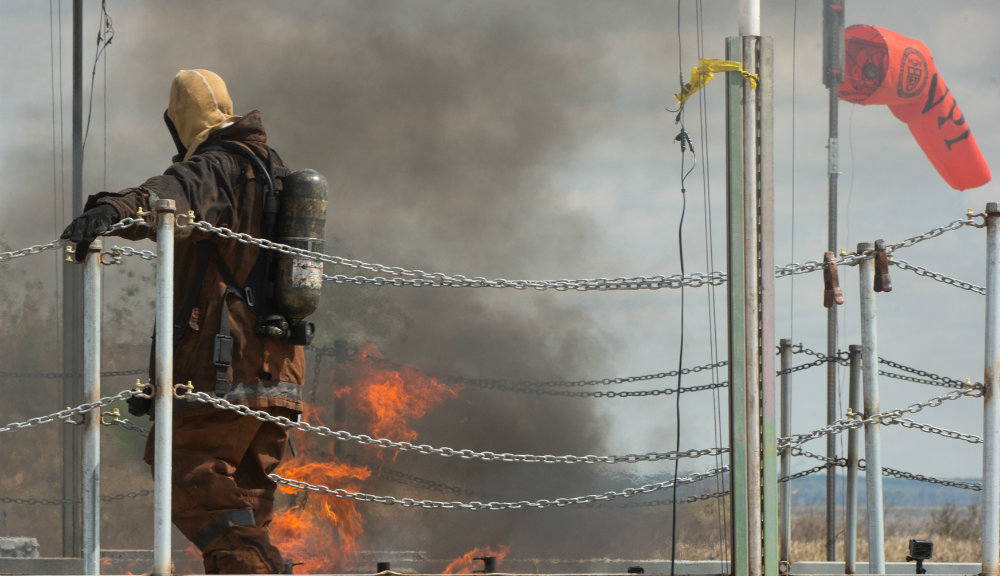From the effects of cultural bias on building evacuation, to the analysis of 911 response times in the United States, to the dynamics of forest fires and dust explosions, a wide range of research projects conducted by students in Worcester Polytechnic Institute's (WPI) fire protection engineering program were presented recently at the National Fire Protection Association’s (NFPA) annual conference.
Founded in 1896, the NFPA is the leading global organization focused on reducing the loss of life and property from fire. This year's conference marked the first time student projects were solicited and presented for the NFPA membership to review at a dedicated research-section event. A total of 16 posters were accepted by the NFPA, 10 of which were from WPI students.
"We were looking for a way to have research highlighted more at the conference, and we wanted to give our section members more opportunities to network and to meet some of the up-and-coming researchers in the field," said Rita F. Fahy, manager of the research division at NFPA. "This was our first year with a student poster session, and I think we saw a nice range of topics and very good quality work."
The WPI student research projects presented in poster format at the NFPA conference:
- "The Effects of Cultural and Social Differences between the West and Saudi Arabia on Emergency Evacuation," by Majed Almejmaj
- "'Ready-to-Use' Building Layouts and Combustible Packages for 3-D Fire Simulations," by Alberto Alvarez
- "Effect of Geometry of Combustible Dust Deposit on Its Hot Surface Ignition," by K. A. Joshi
- "Increasing Building Fire Safety by Bridging the Gap Between Architects and Fire Safety Engineers," by Haejun Park
- "Fire Extinguishers in Academic Settings," by Raymond Ranellone
- "Review of Theoretical Expressions for Laminar Burning Velocity of Particle-Air Flames," by Scott R. Rockwell
- "Obtaining High-Quality Experimental Data in Real-Scale Fire Tests," by Tanya Soffen
- "Piloted Ignition Regimes of Wildland Fuel Beds," by J.C Thomas
- "Fire and EMS Mobilization: From 9-1-1 to Help on the Way," by Robert Upson
- "Study of Interaction of Entrained Coal-dust Particles in Lean Methane – Air Premixed Flames," by Yanxuan Xie
The remaining posters presented at the NFPA conference were submitted by students from Carleton University, University of Canterbury, University of Maryland, Cologne University of Applied Sciences, and the Academy of State Fire Service of Russia (two posters).
"I think this was an outstanding group of posters," said Brian Meacham, associate professor of fire protection engineering at WPI, who is a member of the NFPA’s research section executive committee, but recused himself from the poster selection process. "This work was done by students from leading fire protection engineering programs around the world, and I think the concentration of WPI posters shows the depth and the quality of the research being done by our students."
The annual NFPA conference ran June 12-15 at the Boston Convention and Exhibition Center. The event attracted some 4,300 people from around the world, who work in all facets of fire protection. The conference included a wide range of seminars and displays from 370 companies involved in the fire protection industry.
"I was very pleased with the turnout for the poster session," said Kathy Ann Notarianni, professor and head of WPI's Department of Fire Protection Engineering. "The room was full, and people were engaging with the students, asking them questions and having good discussions about the next steps of their research. The impact was very strong."
WPI fire protection engineering graduate students come from such diverse disciplines as chemical, mechanical, electrical, and civil engineering, architecture, and more.
For students with an undergraduate foundation in traditional engineering fields, WPI's fire protection engineering courses lay the groundwork for a firm understanding of the dynamics of fire and its causes and prevention, and how to protect structures, vehicles, clothing, and people.
WPI offered the nation's first master's degree program in the field, and the university was the first to provide a graduate-level program in fire protection engineering via distance learning. WPI’s research-based doctoral program in fire protection was established in 1991. WPI has conferred more than 700 master's and doctoral degrees in fire protection engineering and currently delivers programs to students hailing from more than 30 countries.
To accommodate the growth of the program, and to expand areas of research, a new fire science research and education center with a next-generation burn laboratory is now under construction at WPI’s Gateway Park.


